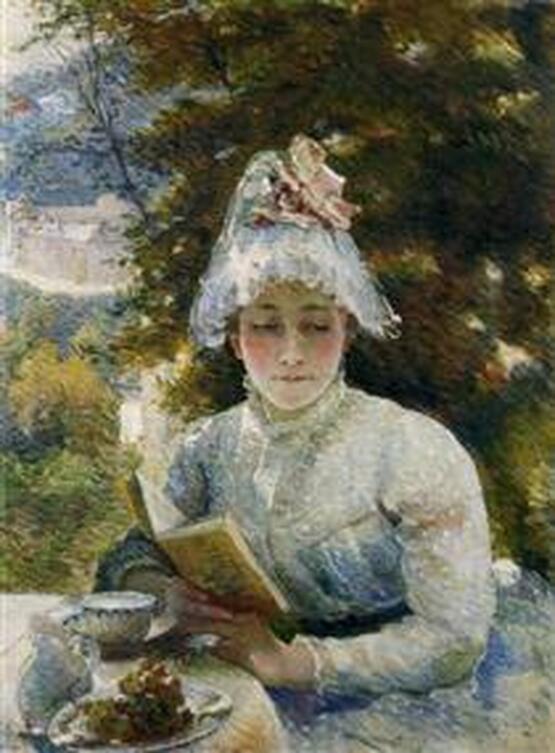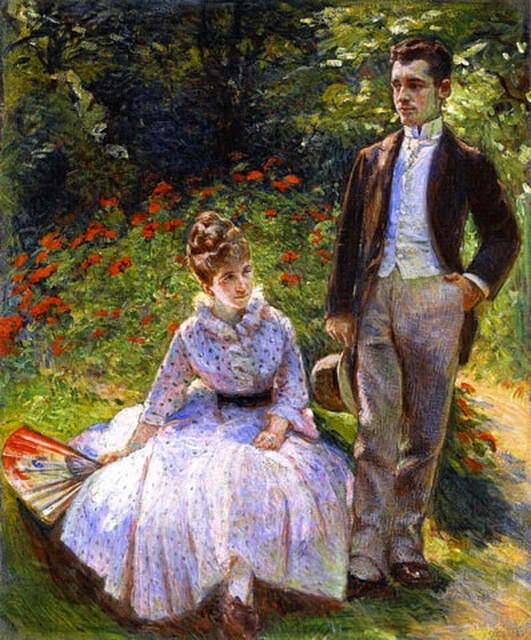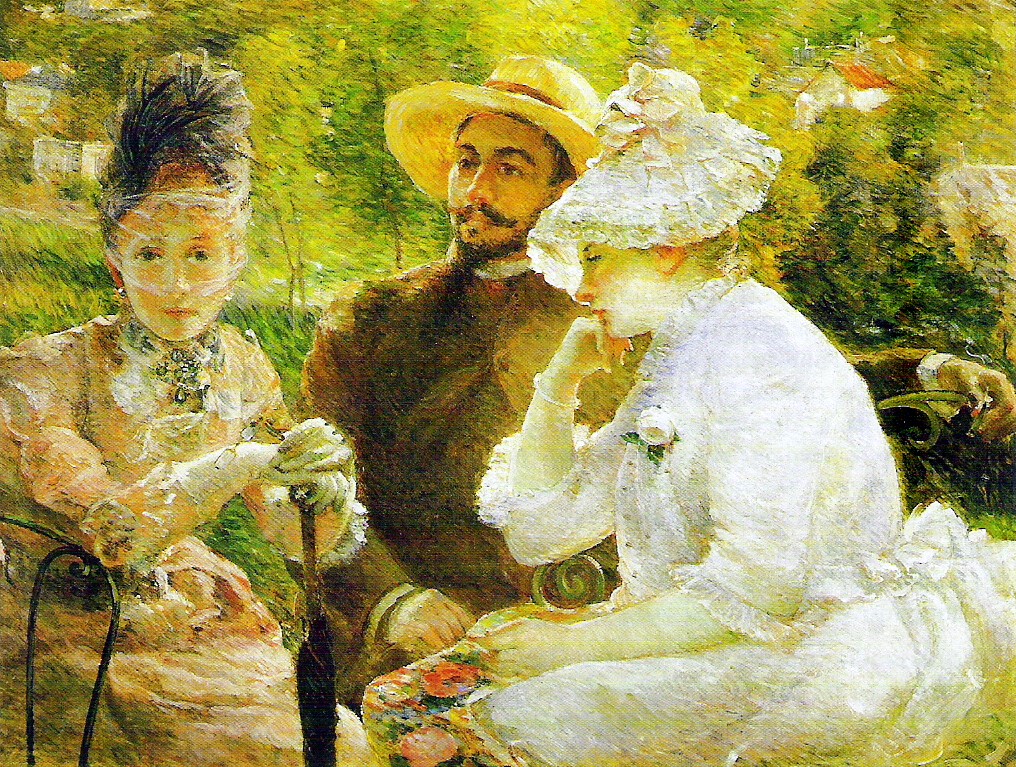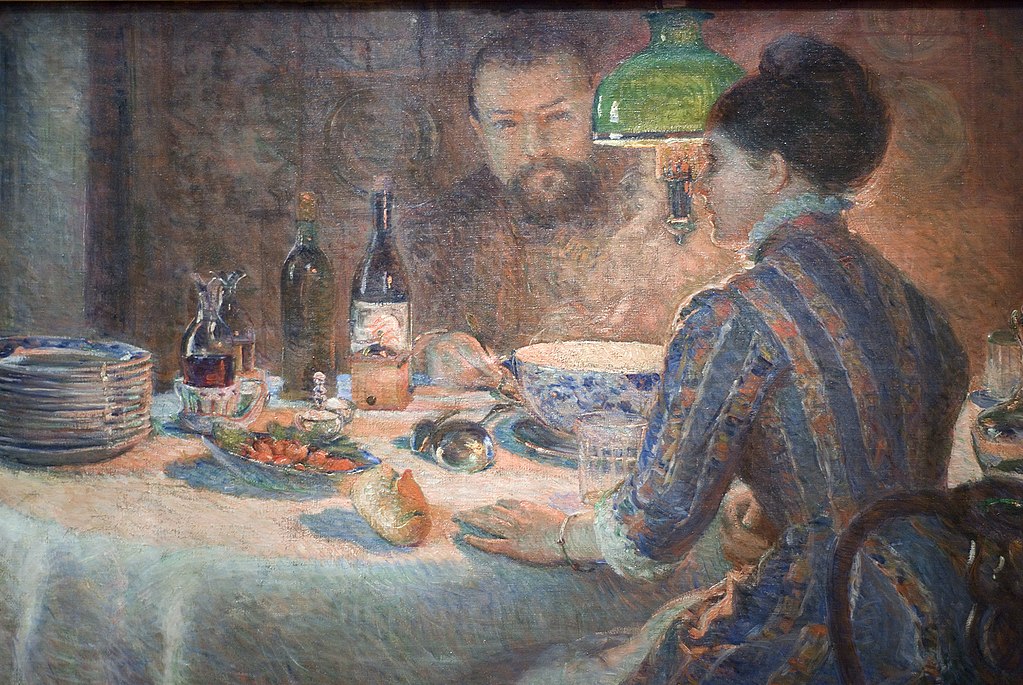AN APPRECIATION: Marie Bracquemond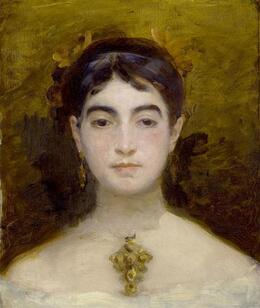 Self-portrait. Self-portrait.
Marie Bracquemond along with Berthe Morisot and Mary Cassatt, is often listed as one of the three great Impressionist artists. Her path to becoming an Impressionist was quite different than that of most of her Impressionist colleagues and she arrived on the scene relatively late. However, she fully embraced the style and produced a number of masterpieces. Like quite a few of her Impressionist colleagues, her artistic career was cut short by tragedy.
Career Born Marie Anne Caroline Quivoron in December 1840 near Brest in Brittany, Marie had to struggle as a child. Her father, a sea captain, died when she was still young. Her mother, Aline Hyacinthe Marie Pasquiou, became involved with Emile Langlois and the family led a nomadic existence moving between various locations in France and Switzerland. Marie showed a talent for art at an early age. Her first work was a picture she did for her mother's birthday using pigments she had made from flowers. When she grew older, it was arranged for her to study with Auguste Vasser, an artist who restored paintings and who gave lessons to young ladies living near Etampes where her family was then living. In 1857, at the age of 16, she submitted one of her paintings for exhibition at the prestigious Paris Salon. The jury accepted the painting - - quite an accomplishment for a teenage girl from the provinces. As a result of this success, she was introduced to Jean-Auguste-Dominique Ingres, the grand old master of French art at the time. Ingres was so impressed that he took Marie into his studio. However, Ingres had doubts about how committed a woman could be to art and gave Marie the less important tasks in the studio such as painting flowers and stillifes. Frustrated, Marie left Ingres' studio and began to get commissions of her own. One of these was from the Empress Eugene, wife of Napoleon III, entitled “Cervantes In Prison”. The success of that commission led to her receiving a government commission to copy paintings in the Louvre. Also, from 1864 on, her works were regularly accepted for exhibition at the Paris Salon. Thus, while still in her 20s, Marie was well on the road to becoming a successful artist. Although she did not attend the official art school, the Ecole des Beaux Arts (women were not allowed to enroll as students), she worked in the accepted academic style. Furthermore, her credentials included having been a student of Ingres, still the most respected of the establishment artists. While copying paintings at the Louvre one day, something happened that would change Marie's life in more than one way. She was spotted by Felix Bracquemond, an artist specializing in prints and ceramics. An introduction was arranged and Marie and Felix became inseparable. In 1869, they were married despite her mother's objections. A year later, they had their only child, a boy who was named Pierre. At first, it seemed like an ideal match for a pair of artists - - two people who were passionate about their art and about each other. Felix taught Marie etching and involved her in his various ceramics projects. He also introduced her to other artists including some of the avant garde artists who were living and working in Paris. Felix was interested in Japanese prints. His work in this area brought him to the attention of artists such as Edouard Manet and Edgar Degas. Indeed, by the early 1870s, Felix had built a reputation and was well-respected as a printmaker, regularly showing his work at the Paris Salon. Some of Felix's more avant garde acquaintances were not having the same luck with the Paris Salon and were thinking of holding their own independent exhibition. Degas thought that it might give this exhibition more credibility if it also included works by some artists who were more accepted by the art establishment. Felix accepted Degas' invitation and so became one of the artists who exhibited at the First Impressionist Exhibition of 1874. Through Felix, Marie met a number of the Impressionists including Claude Monet and Pierre-Auguste Renoir as well as Degas. As a result of these meetings, Marie's artistic style began to change. By the end of the 1870s, she had become a full-fledged Impressionist. Accordingly, she exhibited at the Fourth (1879), Fifth (1880) and Eighth (1886) Impressionist exhibitions. Felix was far from supportive of Marie's new direction. He harshly criticized her work and would hide her paintings when people came to their house. Most articles attribute this behavior to a dislike of the Impressionist style, particularly the Impressionists' use of color. However, Felix's supposed contempt for the Impressionist approach to art did not prevent him from exhibiting his own work at the First and Fourth Impressionist Exhibitions. Nor did it prevent him from being friends with the leading Impressionists and socializing with them. Thus, there must have been more to his hostility to Marie's work than an objection as to style. Indeed, in a biography that Pierre wrote about his parents, he describes how his father would bitterly rebuff his mother's attempts at reconciliation. In short, there was nothing Marie could do right according to Felix. This rift broadened in 1886 when Felix introduced Paul Gauguin to Marie. To Felix's disapproval, Gauguin showed Marie how to intensify the colors of her paintings. By 1890, Felix's attacks had caused Marie to become reclusive, rarely producing art except for a few private works. She died in Paris in January 1916. In effect, the world was deprived of nearly 30 years of her talent. Analysis There are relatively few of Marie Bracquemond's works in circulation. Two reasons account for this. First, Marie's earlier work was in the French 19th century academic style. While this style was very popular at the time, it has not survived the test of time and, with a few exceptions, such works are rarely exhibited except for historical purposes. Traces of Marie's studies with Ingres can be found in her Impressionistic paintings. Although the Impressionists were scornful of the academic approach to art, they did not reject all aspects of it. Indeed, Degas frequently quoted the advice that he received from Ingres on the importance of line in paintings. Thus, Marie's use of some academic technique does not disqualify her as an Impressionist. On the contrary, she made use of what she learned from Ingres to enhance her Impressionism. Second, as discussed earlier, nearly 30 years of her career were left effectively dormant. Considering the beauty of the work she did from the late 1870s into the 1890s, one can only imagine what she could have produced. Whether the crushing hostility directed at Marie was the result of a romantic relationship gone sour or the chauvinist brutality of a husband who could not deal with his wife's success, the result is that we have relatively few of her Impressionistic works. Like Morisot and Cassatt, Marie focused primarily on domestic subjects. In the second half of the 19th century, this was the world that respectable women were allowed to inhabit. Respectable women could not go off to the cafes and dance halls like their male counterparts and paint those aspects of modern life. Like Renoir, Marie liked to place people in outdoor scenes. This enabled her to incorporate more color in her portraits and genre paintings. After her meeting with Gauguin, her works became particularly colorful. See our profiles of these other Impressionists and members of their circle.
Frederic Bazille Eugene Boudin Gustave Caillebotte Mary Cassatt Paul Cezanne Edgar Degas Henri Fantin-Latour Eva Gonzales Paul Gauguin Armand Guillaumin Edouard Manet Claude Monet (Part I The Early Years) Claude Monet (Part II High Impressionism) Claude Monet (Part III The Giverny Years) Berthe Morisot Camille Pissarro Pierre Auguste Renoir Alfred Sisley Suzanne Valadon |
Above: "The Tea"
Below: "The Artists's Son and Sister in the Garden at Sevres." Above: "On the Terrace at Sevres."
Above: "Woman With An Umbrella"
Below: "Three Women with Parasols" (Also known as "The Three Graces"). Above: "Under the Lamp."
|
Artist appreciation - Marie Bracquemond
